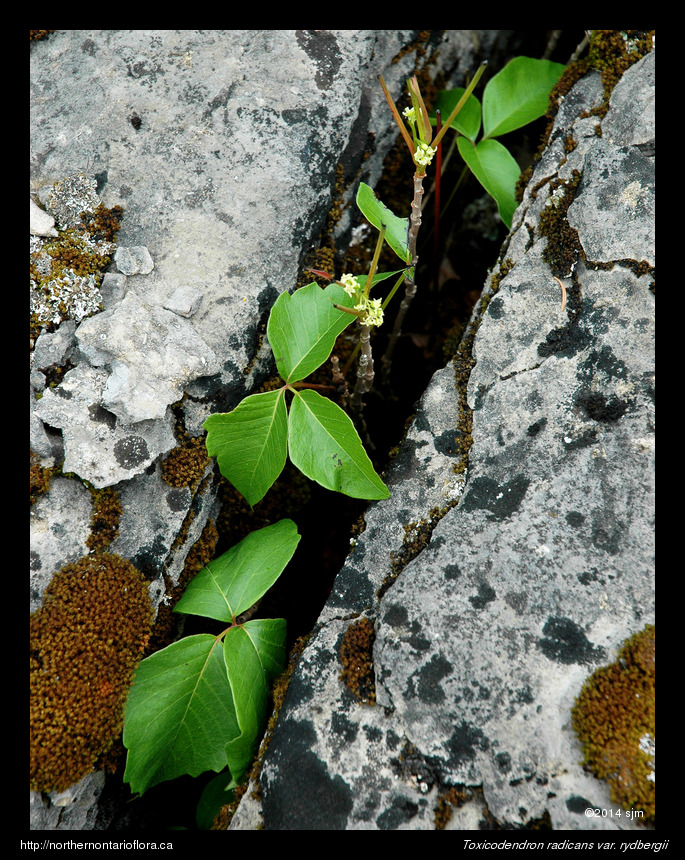
|
Northern Ontario Plant Database 
Plant DescriptionToxicodendron radicans var. rydbergii (Small ex Rydb.) ErskineEn: non-climbing poison ivy, Rydberg's poison ivy, western poison ivy
Anacardiaceae (Poison ivy Family) General: An erect deciduous shrub, up to 1 m tall, but usually shorter (2-6 dm) in northern Ontario; spreading by rhizomes and often forming large patches or colonies. Twigs are light brown with blunt (obtuse) to pointed (acute), slightly pubescent, naked buds. Aerial roots are lacking. Like all Toxicodendron species, western poison ivy will cause a blistering rash in sensitive people. The specific cause of the rash is urushiol, a resinous oil that causes contact dermatitis. Other plants in the Anacardiaceae that contain urushiol include cashews, pistachios, and mangoes; each of these may cause problems when ingested by people hypersensitive to poison ivy.Nomenclature: Toxicodendron rydbergii was originally named Rhus rydbergii Small ex Rydb., but it is considered by some botanists to be a variety of eastern poison ivy, Toxicodendron radicans var. rydbergii (Small ex Rydb.) Erskine. Leaves: Alternate, compound, with 3 leaflets (trifoliolate). The leaves, borne on long stalks (petioles), 5-23 cm long, are variable in shape and size, but generally each of the 3 leaflets are broadly elliptic to ovate, 4-15 cm long. Leaves may be dull or shiny above; the lower surface is paler; leaflets often appear to be drooping. Both leaf surfaces are smooth (glabrous), but veins on the lower surface of the leaflets are minutely hairy. The leaflet bases are tapering (cuneate) to rounded, while the tips are sharply pointed (acuminate); margins may be entire, coarsely toothed, or slightly lobed. The upper, or terminal, leaflet has a long stalk (petiolule), while the pair of lower leaflets are sessile - attached directly to the leaf axis, or attached by short stalks. The lower leaflets are asymmetrical, with a wider blade below the midrib than above it. Leaves are often tinged with red when they first emerge, later turning yellow to red in autumn. Flowers: Bisexual, yellowish-green to creamy-white, with several to numerous small flowers borne in erect clusters (panicles), 5-13 cm long, in the axils of upper leaves. Calyx minute; corolla with 5 rounded lobes; stamens 5; the single pistil has an inferior ovary. Flowers bloom in late spring to early summer. Fruit: Small, spherical, creamy-white to yellowish drupes, 4-6 mm long, smooth and vertically ribbed. Fruits mature in late summer. Habitat and Range: Disturbed woods, clearings, rights-of-way, roadsides, sandy or rocky areas, and cracks in limestone bedrock. Western poison ivy is native to north temperate and boreal North America. In Ontario, its general range extends to about 51° N (Soper & Heimburger 1982). Internet Images: The Toxicodendron rydbergii webpage from the Shrubs of Wisconsin website. Poison Ivy Facts: The Poison Ivy, Oak, Sumac Information Centre website includes much useful information on poison ivy and related species. To prevent getting a poison ivy rash, first learn to accurately identify poison ivy. Obviously, the only way to avoid contact is to stay away from the plant, but when hiking where poison ivy is known to occur, it is a good idea to wearing protective clothing (long pants, long sleeves). There are products available, such as IvyBlock®, that may help to prevent urushiol from binding to your bare skin, but if your skin does comes into contact with poison ivy, you may be able to remove some of the urushiol by wiping the exposed area with isopropyl alcohol (rubbing alcohol) or washing it with warm, very soapy water (plain water only spreads the oil!). This should be done as soon as possible after exposure. Your skin needs to come in contact with urushiol to get a rash, but the oil may first be transferred to your clothes and shoes when walking through poison ivy and on to your skin later. So, be sure to wash your hiking clothes in hot soapy water if you think you have travelled through poison ivy; shoes can be swabbed with rubbing alcohol and/or scrubbed with hot soapy water. Properly dispose of all towels or cloths used to clean shoes, clothes, or skin in sealed bags in the garbage. Pets may also transfer urushiol from their fur to you, so you will need to wash pets with warm soapy water if you know or suspect they have come in contact with poison ivy. Urushiol oil can remain active from 1 to5 years on any surface and a rash will not develop immediately, it usually takes 1-3 days for the rash to develop. Trying to eradicate poison ivy on your property by burning it will release microscopic droplets of urushiol into the air, which, if breathed in, will cause a rash in your lungs - a far more serious and potentially life-threatening problem than a simple rash on your outer skin. Remember too that all parts of the poison ivy plant contain urushiol, so kneeling on or handling leafless poison ivy twigs during winter can still transfer urushiol to your skin or clothes. So, learn to identify it and stay away! Similar Species: Toxicodendron radicans, the eastern poison ivy, is a climbing vine that clings by means of numerous small aerial rootlets to tree trunks and other tall structures. It occurs commonly in southern and easternmost Ontario, but does not extend north onto the Canadian shield. See the Toxicodendron radicans webpage from the Wildflowers of Illinois website. The Toxicodendron radicans website from the Soutwest Colorado Wildflowers, Ferns, & Trees website. Back to species list |
||||||||||||||||||||||

























